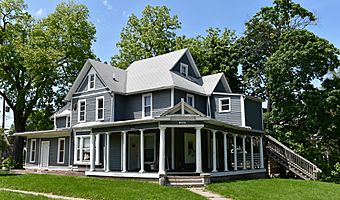Prospect Park Second Plat Historic District facts for kids
Quick facts for kids |
|
|
Prospect Park Second Plat Historic District
|
|
 |
|
| Location | Roughly from the Des Moines River south to Franklin Ave., between 6th Ave. and 9th St. Des Moines, Iowa |
|---|---|
| Area | 23 acres (9.3 ha) |
| Architectural style | Late 19th And 20th Century Revivals Late 19th and early 20th century American movements Late Victorian |
| MPS | Towards a Greater Des Moines MPS |
| NRHP reference No. | 98000375 |
| Added to NRHP | April 23, 1998 |
The Prospect Park Second Plat Historic District is a special neighborhood in Des Moines, Iowa. It's known for its old homes built in the late 1800s and early 1900s. This area was once a fancy suburb called North Des Moines. It became a nationally recognized historic district in 1998. This means it's important to American history and worth preserving.
Contents
Exploring the History of Prospect Park
This historic district grew in different stages. The first part, called Official Plat of Government Lot 2, was planned in 1886. The main section, Prospect Park Second Plat, was planned a year later in 1887. It was updated in 1888. The last part, Glen Baily Plat, was added much later in 1922. The important historical period for this district ended in 1937. This was when Hickman Road was built through to Sixth Avenue.
Different Areas of the District
The historic district has three main parts. The area north of Hickman Road, near the Des Moines River, has larger lots. These homes had amazing views of the river valley. This is where the wealthier families lived.
South of Hickman Road, between Seventh and Ninth Streets, the lots were smaller. These homes did not have river views. A streetcar line on Sixth Avenue helped this area grow. People could easily travel before cars became common.
Initially, the homes along Sixth Street were for single families. Later, in the 1920s, Glen Baily built seven apartment buildings there. This changed the area into rental properties.
How the Area Developed
The district also shows how real estate worked back then. New ideas like "residential parks" changed how neighborhoods were planned. Large pieces of land were divided into smaller lots over time. Real estate companies helped fund these big projects. They also used new ways to advertise and sell homes.
Architectural Styles of the Homes
The houses in this district show many popular styles from the late 1800s and early 1900s. These homes belonged to middle and upper-middle class families. Some houses were even shown in local magazines. This helped make certain styles popular in Des Moines.
Famous Architects and Landscape Design
Several well-known Des Moines architects designed homes here. These included Norman T. Vorse, Kraetsch & Kraetsch, and Hallett & Rawson. Most of their larger homes are found north of Hickman Road, near the river.
The way the land was designed, called landscape architecture, was also important. Prospect Park Second Plat was planned like a "residential park." This means it used the natural land, had park-like areas, and curvy streets. It connected the older, grid-like city blocks to the south with the newer, irregular streets to the north.
Popular House Styles You Can See
The Queen Anne style was very common when the district first grew. You can find these homes along Franklin Avenue, from the Des Moines River to the district's southern edge.
The Colonial Revival style became popular soon after. Many examples of this style are on Ninth Street. A larger, more upscale Colonial Revival home is at 1908 Seventh Street.
You will also see several American Four Square style homes. These are found throughout the southern part of the historic district. The American Craftsman style is also present. Larger Craftsman homes are north of Hickman Road. Smaller ones are on the north-south streets.
Unique Architectural Examples
A few architectural styles have only one example in the district. The F. A. Kern House at 717 Franklin Avenue is a Prairie School style home. There is another Prairie School house on the same street, but it's in The Oaklands Historic District. You can also find a single Mission Revival style house on Seventh Street.



